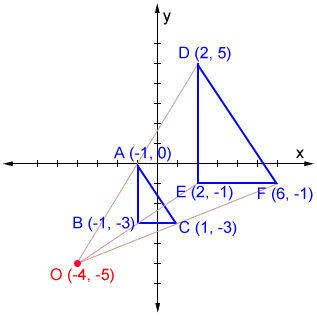Dilation
In mathematics, dilation is a type of transformation in which the size of a shape or geometric figure is changed, but the relative proportions and shape remain the same.

The quadrilateral and cube above are dilated to produce smaller versions of the respective shapes. The model airplane to the right is dilated to one-thousandth the size of the real plane.
The term "preimage" is used to refer to a geometric figure before it has been transformed and the term "image" is used after it has been transformed. Dilation is a non-rigid transformation, which means that the distance between points in the preimage and image don't remain the same; the preimage and image are not congruent. Dilation can refer to either an increase or a decrease in size. If the figure increases in size as a result of the dilation, this is referred to as enlargement; if a figure decreases in size as a result of the dilation, this is referred to as reduction. Below are several examples of dilations.
Scale factor
A scale factor is a number by which a quantity is multiplied, changing the magnitude of the quantity. In the context of dilation, the scale factor is the value that determines both whether the preimage increases or decreases in size, as well as the magnitude of the change with respect to a fixed point called the center of dilation. A center of dilation can either be part of the preimage or outside of the preimage. Below are some examples of both cases.
Scale factor between 0 and 1.
If the scale factor is between 0 and 1, the preimage decreases in size.
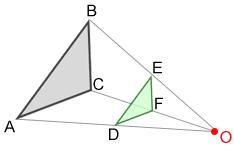
The preimage of triangle ABC is dilated with respect to point O by a scale factor of to produce the image of triangle DEF. The length of each side of the preimage is multiplied by
to produce each corresponding side of the image. Also, points on triangle DEF are
the distance from O relative to their corresponding points on triangle ABC.
Scale factor greater than 1
If the scale factor is greater than 1, the preimage increases in size.
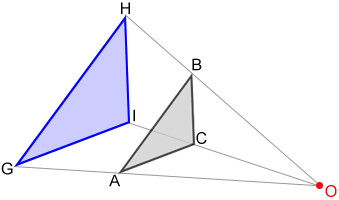
Triangle ABC is dilated with respect to point O by a scale factor of to produce triangle GHI. The length of each side of the preimage is multiplied by
to produce each corresponding side of the image. Also, points on triangle GHI are
the distance from O relative to their corresponding points on triangle ABC.
Scale factor equal to 1
If the scale factor is equal to 1, the preimage does not change; it is congruent to the produced image.
Where does the image "land"?
When the scale factor is between 0 and 1, the image is between the preimage and the center of dilation. When the scale factor is greater than 1, the preimage is between the image and the center of dilation.
Below is a diagram showing a composite of the two dilations of triangle ABC.
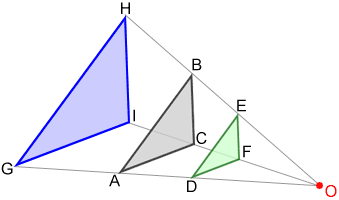
Triangle DEF lies between the preimage of triangle ABC and point O, the center of dilation, since the scale factor was less than 1. Triangle ABC lies between the dilated triangle GHI and the center of dilation since the scale factor was greater than 1. Also, all three triangles are similar.
The closer the scale factor is to 1, the closer the image of the dilated triangle is to the preimage. Triangle ABC is dilated by a scale factor of to produce triangle DEF:
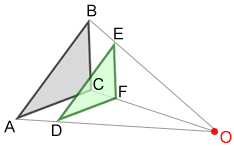
How to determine the scale factor
The scale factor can be determined by taking the ratio of the distance between a point on the image and the center of dilation to the distance between a corresponding point on the preimage and the center of dilation.
Example:
Find the scale factor if quadrilateral ABCD is dilated to produce quadrilateral EFGH for the center of dilation O below.
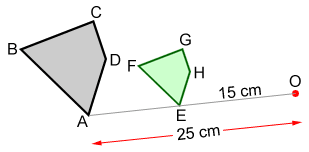
This means that the lengths of the sides of quadrilateral EFGH are the lengths of the corresponding sides of quadrilateral ABCD; conversely ABCD is
the size of EFGH.
Dilations in coordinate geometry
In a 2D coordinate plane, a dilation with the origin as the center of dilation and a scale factor of "a" will map a point, (x, y), to (ax, ay). The following are some examples.
Center of dilation outside of the geometric figure
Triangle ABC is dilated by a factor of 0.5 to produce triangle DEF. The coordinates of the vertices of triangle ABC are A (2, 6), B (4, 6), and C (4, 2). Dilating triangle ABC by a factor of 0.5 results in triangle DEF with vertices D (1, 3), E (2, 3), and F (2, 1).
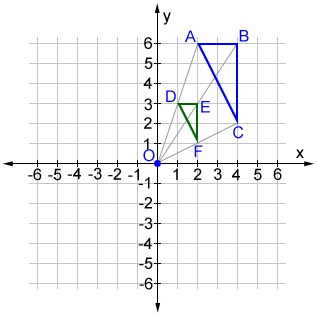
Center of dilation inside of the geometric figure
Triangle ABC is dilated by a factor of 2 to produce triangle DEF. The coordinates of the vertices of triangle ABC are A (-2, -3), B (-3, 2), and C (3, -1). Dilating triangle ABC by a factor of 2 results in triangle DEF with vertices D (-4, -6), E (-6, 4) and F (6, -2).
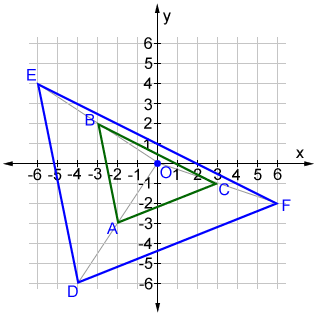
Negative scale factors
When the scale factor is negative, the origin lies between the preimage and the image. The size of the image is the same as it is when the scale factor is positive, but is graphed in the opposite direction.
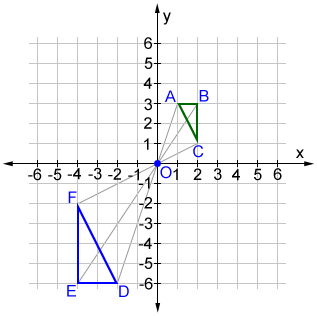
Triangle ABC is dilated by a scale factor of -2 to produce triangle DEF. The coordinates of the vertices of triangle ABC are A (1, 3), B (2, 3) and C (2, 1). Dilating triangle ABC by a scale factor of -2 results in triangle DEF with vertices D (-2, -6), E (-4, -6), and F (-4, -2).
Center of dilation is not the origin
Let (c, d) be the coordinates of the center of dilation. Given that a is a scale factor that is greater than zero, the point (x, y) is dilated to a point (x', y'), as shown below.
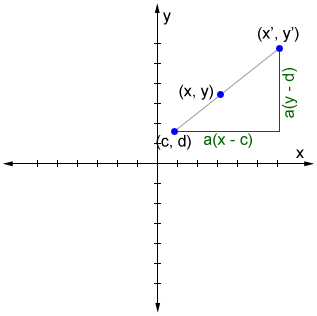
To determine the coordinates of the dilated point, add the horizontal and vertical distances to the x- and y-coordinates of the center of dilation:
(x', y') = (c + a(x - c), d + a(y - d))
Example:
Dilate triangle ABC given vertices A (-1, 0), B (-1, 3), and C (1, -3), scale factor of 2, and a center of dilation of O (-4, -5).
Using the formula from above, we can find the coordinates for the new vertices D, E, and F and graph them as follows:
| D = | (-4+2(-1-(-4)), -5+2(0-(-5))) |
| = | (2, 5) |
| E = | (-4+2(-1-(-4)), -5+2(-3-(-5))) |
| = | (2, -1) |
| F = | (-4+2(1-(-4)), -5+2(-3-(-5))) |
| = | (6, -1) |
